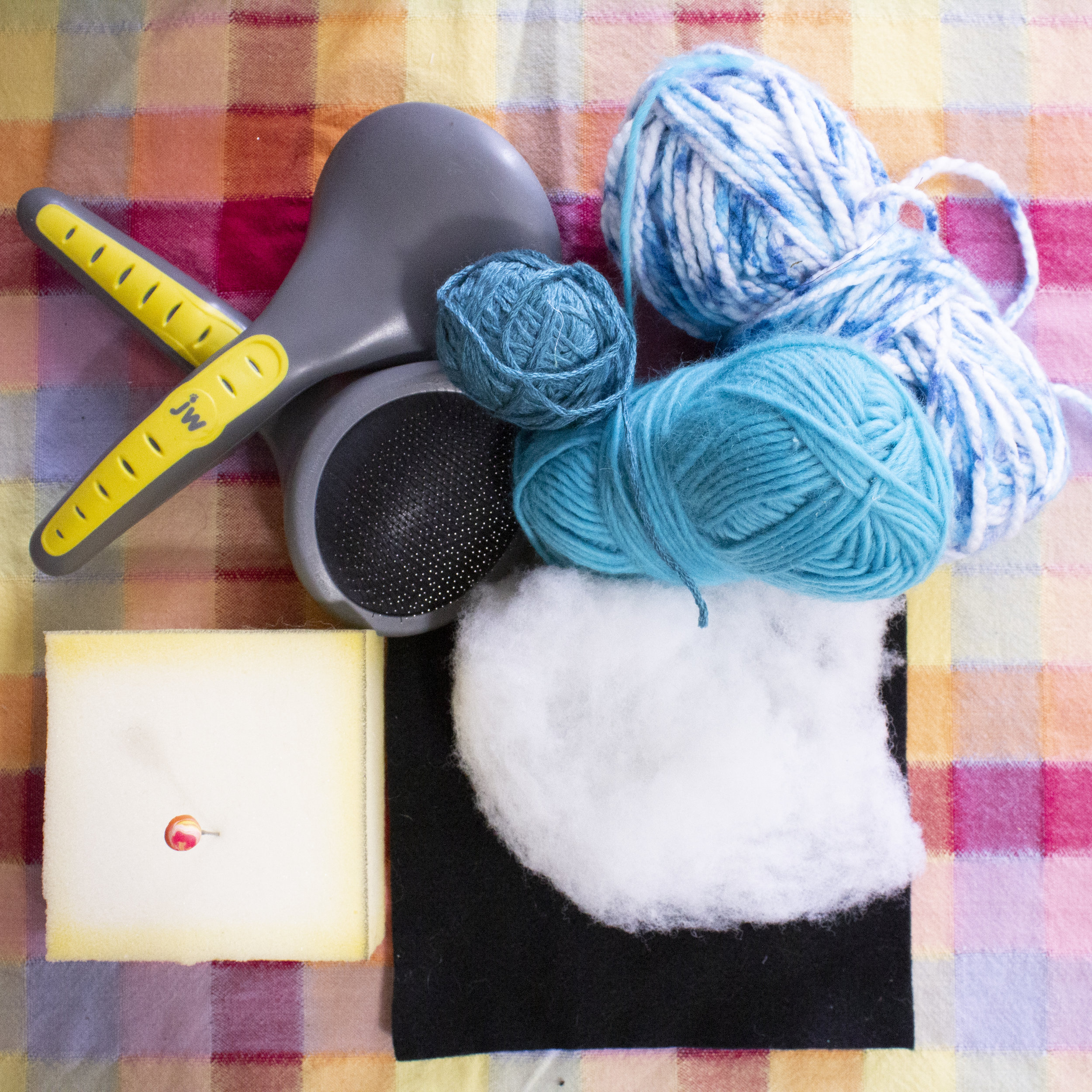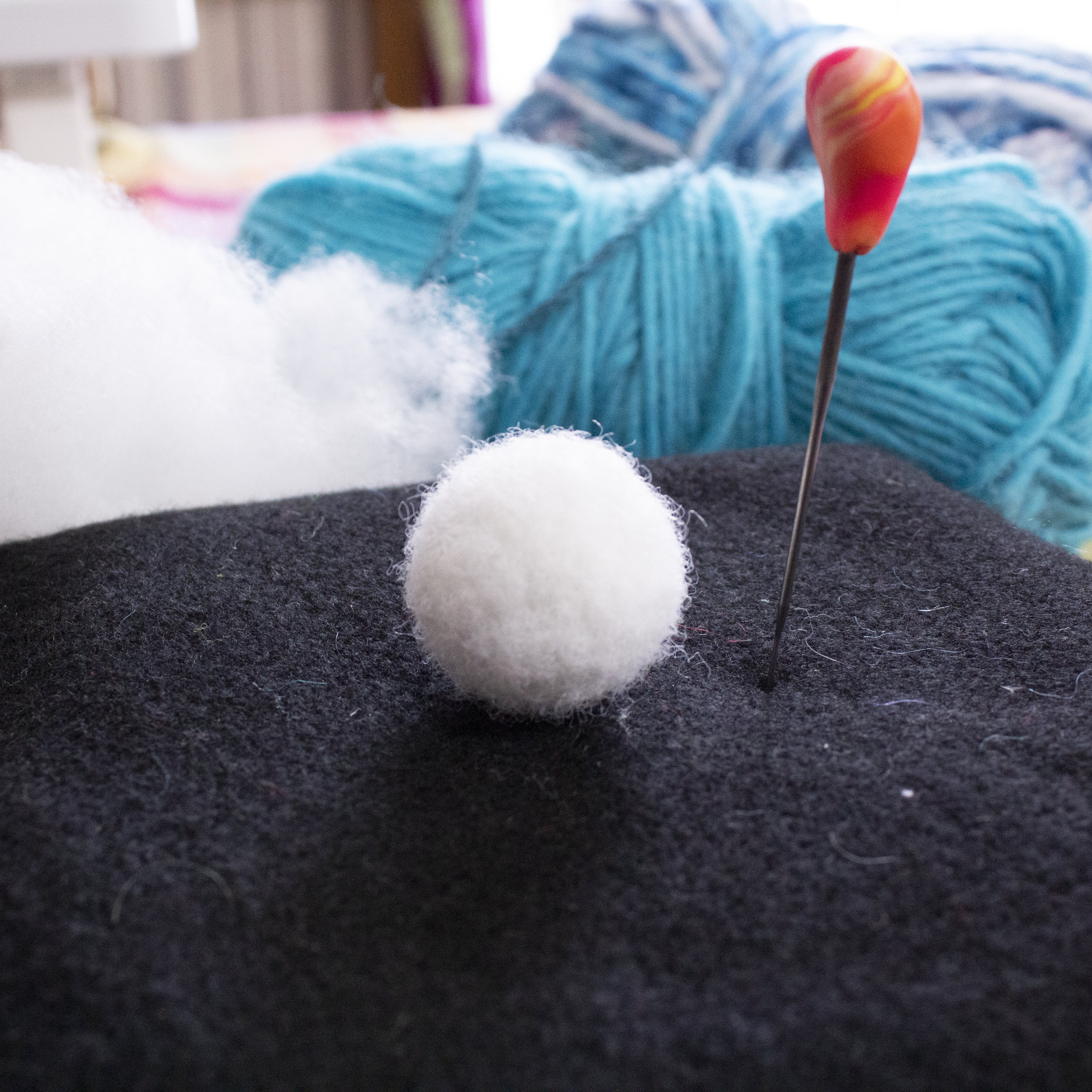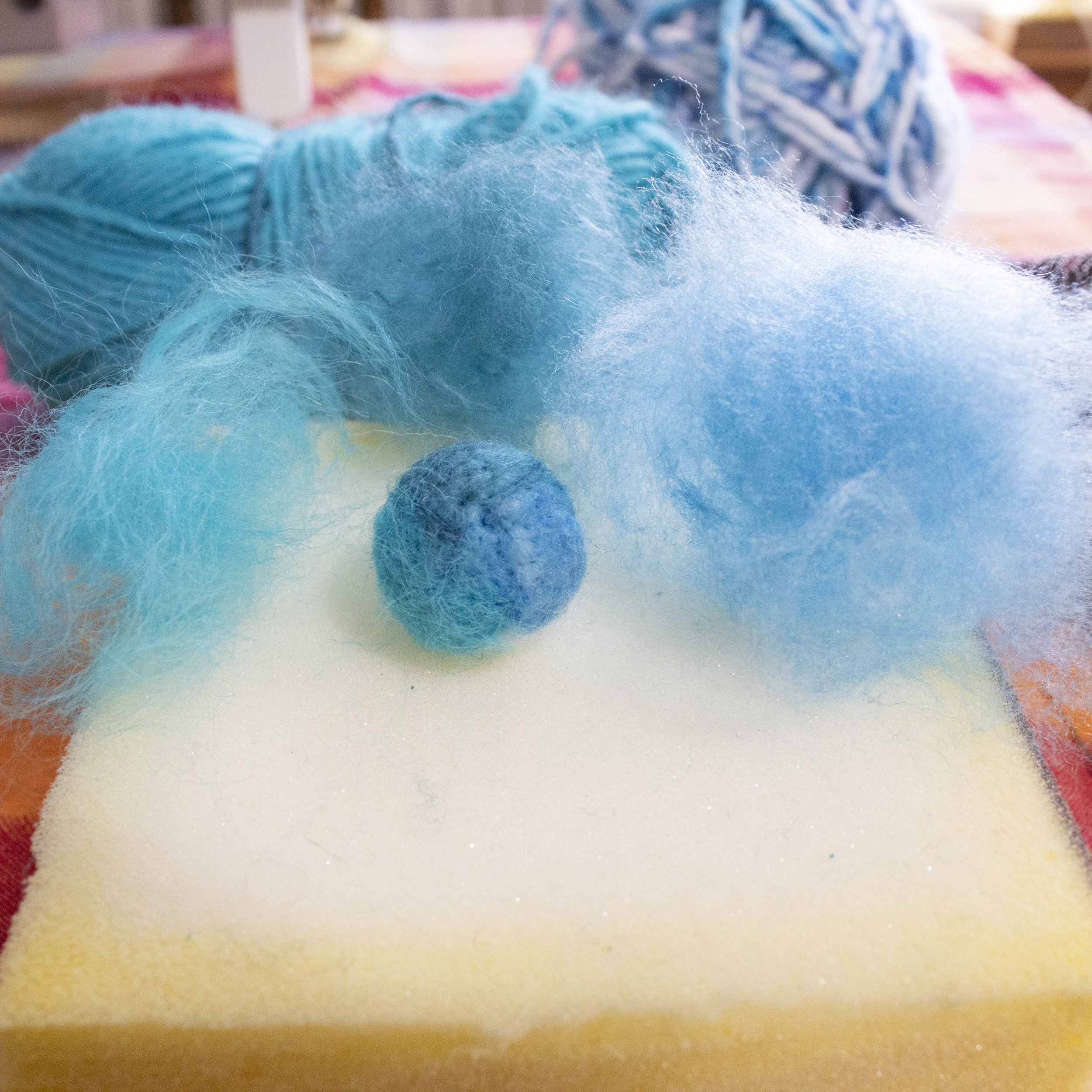Reclaiming Fiber from Yarn
FTC Disclosure: Please note that some of the links in this post are affiliate or referral links (full disclosure here), and if you make a purchase or sign up for a service within a certain timeframe after clicking on one of those links, I may earn a small commission paid by the retailer at no extra cost to you. I wouldn't recommend anything that I don’t or wouldn't use myself. Thank you for your support!
This post was last edited/updated in March 2021.
I need to preface this post by mentioning that I am not a vegan needle felter, and I have no intention of becoming one, so my ability to answer any questions will be limited in scope. For example: I only used the yarns that I had on hand that I knew were not animal fibers or blends, and I lost the wrappers so I couldn’t tell you which ones are which, so it will be difficult for me to tell you which specific yarns are best for needle felting. This is a guide, and the rest is up to you to figure out what works best for you and what doesn’t. There is a real noticeable difference between needle felting with wool versus man-made fibers, especially when it comes to 3D work, but it is absolutely doable.
Unless you’re needle felting with banana fibers (which you can buy in wool supply, it’s like silk, but I can’t speak to what it’s like for needle-felting yet), I am unaware of any biodegradable fibers that are easy to get that you can use for needle felting. That’s a future exploration blog post topic.
By the way, I have a curated list of the items mentioned in this post available on Amazon. The wool-free felting stuff is towards the bottom of the list (though the other felting tools like the foam, needles and slicker brushes are on there as well).
Clockwise from top left: pet brushes, non-wool yarns, poly-fil (on top of craft felt), foam, felting needle
So, what if I told you that vegan needle felting is not only accessible, it’s possibly even more accessible than needle felting with wool? Unless you’re lucky enough to live in an area which has fiber shops that carry good quality needle felting supplies and tools, chances are that your only physical access to craft materials are the big box craft supply stores (Michael’s, A.C. Moore, Hobby Lobby, Joann, occasionally Walmart/Kmart for limited things). Most of us have to buy our wool online.
The thing is, you can needle felt with yarn. If it’s not a protein fiber, you can’t wet felt it, because it won’t stick. Needle felting works differently though, by physically forcing the fibers to get tangled up with each other, and that’s what will work in your favor.
You will still need the basic tools: needles and a felting base.
Marble-sized ball needle felted from poly-fil fiber.
For 3D needle felting, instead of core wool, you will want to buy some poly-fil. A box like this will last you a really long time, but you can also just go buy a bag of the stuff in the craft store. For 2D fiber painting, you’ll want to pick up some felt fabric, or try other materials out like cotton or linen. Experiment and see what works for you. Pretty easy so far!
A note on needle felting with fiber fill, or poly fill, or whatever it’s called. If you are used to needle felting with wool, it is going to feel very very different, and I think it will require a different approach than needle felting with wool. First of all, it felts up very quickly, and it becomes really hard really fast. If you plan to cover it with a top color, I think you need to make sure it doesn’t end up too dense, or you’ll end up feeling like you’re trying to stab a rock. It’s also lumpier and a bit more difficult to tweak. It’s definitely feltable, and I think it will make an excellent substitute to core - just realize that new/different materials take some getting used to.
Three types of yarn: worsted, some hairy crap, and woolen
The next thing you’ll need is some spun yarn that’s made from acrylic, nylon, rayon, etc. I’m not sure how well cotton yarn would work - the only stuff I have is more thread-like and not fluffy. The novelty yarns won’t work (chenille, loopy, ladder, feather, etc). Get the stuff that looks like what your grandmother used to knit sweaters. You’ll also need a pair of pet slicker brushes - I use dog-size brushes because they’re larger, such as these. There are dog brushes with balls on the end, but I’m not sure how well those work so if anyone has tried those feel free to leave a comment. You will also want to grab a pair of scissors, because you need to cut the yarn into “staples” (length of fiber). Worsted or woolen doesn’t matter, though I think the woolen is easier to work with and faster to un-spin and re-fluff. Also, whatever that yarn is that I have in the middle of the photo, you don’t want that. The color is gorgeous, but it’s really hairy, and kinda annoying to needle felt with. The point is, you definitely need to experiment with different yarns - don’t just go buy one of every color before you try them out.
I also happened to come across this bundle of little acrylic yarn bonbons in different colors - I personally haven’t tried them for this purpose, but they look like they would work perfectly, and you would have a nice assortment of colors.
Yarn cut into 3-4 inch long pieces
You’ll want to cut the yarn into 3-4 inch lengths. It doesn’t need to be exact, but I wouldn’t go too much shorter or longer than that. Shorter will make it harder for you to work with it, and longer would really make it harder for you to work with it.
Pulling the fiber by hand against a dog brush.
Take a bundle of yarn in one hand, your dog brush in the other, and lay it facing up on your lap (or table or whatever). Pull the ends of the bundle of yarn over the brush. Using some form of thick material on your lap, you could also flick it open the way spinners flick open locks. Turn the bundle around, holding the fluffy stuff, and do the same, until what you’re holding no longer resembles individual yarns, but more like a bit of wool batting that you see in all the needle felting videos.
Using two pet brushes to finish carding the fiber.
If you have some that’s still a bit twisted in the middle, you can lay the whole thing on the dog brush, grab the other brush, and card it.
Finished product. I am pretty certain that this yarn is a nylon blend of sorts, and it’s my favorite out of the three I tried. It feels like a cross between merino and silk - it’s soft as silk, but fluffier and easier to stab.
Once you have this, you can do pretty much every needle felting thing out there that’s made with wool. The fibers used in yarn are very fine, and therefore not suitable for felting all the way through, but you can use them the way you would use merino.
You could probably even run it through a blending board or drum carder and make your own art batts. Note: if the reason you are reading this post is because of a wool allergy, I highly recommend using brand new carding tools. Wool alcohols (lanolin) will remain on the teeth of carders and transfer to your batt, so you could still trigger your allergies even if it looks clean and you didn’t use wool. If you are a seller of art batts and want to include vegan batts in your shop, make sure you mention in your post if it was carded on the same carders as wool - because cross contamination can definitely be a problem for allergy sufferers.
Needle felted poly-fil ball covered using the three different types of fibers reclaimed from yarn.
Here are the three colors I refluffed tested on the poly-fil core ball I needle felted early in the post. They all do a decent job, though you can definitely see the hairiness here that I was talking about with that aqua one.
2D needle felting on an applique piece on craft felt using reclaimed yarn fiber.
And here is an example of 2D needle felting (fiber painting) using the three refluffed yarns tested on a piece of craft felt. This is some applique square that came in a dimensions kit, though I’m almost certain this is craft felt and not wool felt. The texture is more like craft felt. The only guaranteed craft felt that I had was this primary green color, and that wouldn’t have looked pretty, but the results should be the same. You can also try working on other materials and don’t just have to stick to felt. I found that the 2D needle felting, unlike the 3D one, was very similar to wool painting - in fact, if I didn’t know that these aren’t wool, I wouldn’t have noticed a difference. It’s easy to control and stab into the material.
If you love using wool, I think you should still give this a try anyway, just for fun. You might find that this opens some doors for you. You could even use wool yarns if you want, when you’re short on wool and want a specific color! This method works on any spun yarn. There are some really pretty yarns out there, and you might find that the color you were needing for a project isn’t available in any of the fiber shops, but happens to be in a yarn - so use the yarn! Not only that, but instead of worrying about any customers who might be offended by your use of non-wool fibers, why not offer both? Things made from wool and things made from vegan fibers, so you could include other potential customers who love your work and would love to have it made in their preferred material? Just a thought.
Anyway, I hope you liked this guide, and feel a bit more hopeful about being able to join in on the stabby fun. And if you’re vegan, or allergic, or whatever your reasons are, you’re definitely more than welcome here in my fiber space and pick out whatever is relevant to your learning needs.













